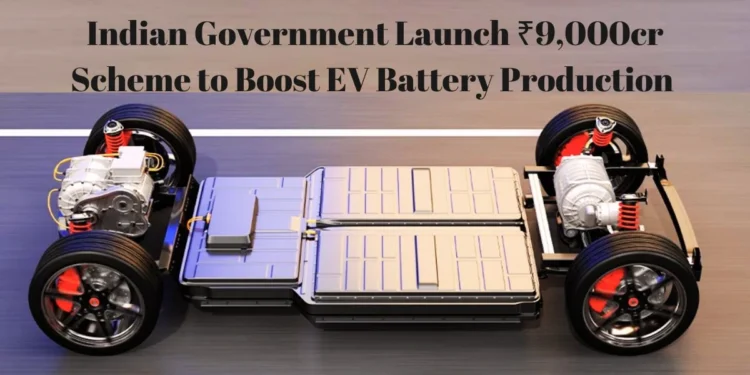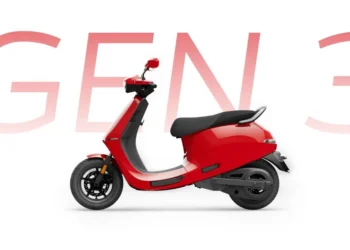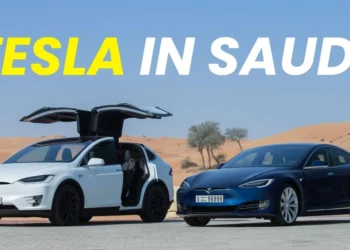India is on the brink of a groundbreaking initiative that could change the landscape of electric vehicle (EV) production and clean energy solutions. The Indian government is likely to launch a ₹9,000 crore PLI scheme to boost EV battery production, focusing on the local manufacturing of critical battery components. This scheme has the potential to not only support India’s EV ambitions but also make the country a global player in the battery supply chain, reducing its dependence on imports, particularly from China.
Table of Contents
What is the ₹9,000cr PLI Scheme for EV Battery Production?
The ₹9,000cr PLI (Production-Linked Incentive) scheme is a strategic initiative designed to foster the local manufacturing of essential EV battery components such as anodes, cathodes, electrodes, electrolytes, and copper foil. These components are crucial for the production of lithium-ion batteries, which form the backbone of electric vehicles. Localizing their production will not only reduce the cost of EVs but will also boost India’s green energy goals, making it a self-sustaining hub for the global battery supply chain.
Key Components Targeted in the Scheme
The primary focus of the ₹9,000 crore scheme is on the production of several vital battery components. These include:
- Anodes
- Cathodes
- Electrodes
- Electrolytes
- Copper Foil
These components require significant capital investment and R&D efforts, which the ₹9,000cr scheme is set to address. The initiative seeks to position India as a key player in the global EV battery manufacturing landscape, challenging China’s dominance in this sector.
How the ₹9,000cr PLI Scheme Could Impact India

India’s EV market is on a rapid growth trajectory, with sales of electric vehicles seeing a 45% increase in 2023-24 alone. As the country aims to reduce its carbon footprint and meet green energy goals, this ₹9,000 crore initiative aligns perfectly with the government’s vision of becoming a global leader in sustainable energy solutions.
1. Reduction in EV Costs
Currently, batteries account for about 40% of the cost of electric vehicles. By localizing production, the Indian government aims to bring down this cost significantly, making EVs more affordable and competitive with traditional fuel-powered vehicles. This cost reduction is a key factor in accelerating the adoption of electric vehicles across India.
2. Reduction of Import Dependency
India’s dependence on China for key battery components like anodes, cathodes, and electrodes has been a significant challenge. The ₹9,000cr PLI scheme aims to reduce this dependency and ensure that India can meet its growing demand for these components from local sources. This initiative is expected to attract substantial investment, reducing the reliance on imports and making India more self-reliant in the long run.
3. Expansion of Manufacturing Capabilities
India’s demand for EV batteries, particularly lithium-ion batteries, is expected to surge dramatically by 2030. This is due to the growing demand for electric vehicles, with projections estimating 260 GWh of demand for lithium-ion batteries by that time. The ₹9,000cr PLI scheme is aligned with these projections, creating a foundation for India to meet this increasing demand through domestic production.
Debi Prasad Dash, President of the India Energy Storage Alliance (IESA), stated:
“Indigenous manufacturing of these components would not only cater to the domestic market but also open up export opportunities, particularly in the US and Europe.”
4. Supporting Green Energy Initiatives
The scheme also aligns with India’s broader green energy objectives, which include green hydrogen and electrolyzer manufacturing. By investing in these sectors, India aims to reduce its carbon footprint while boosting its position as a leader in the clean energy market.
Participation from Key Industry Players
The ₹9,000cr PLI scheme has already sparked interest among some of India’s largest industrial players, including:
- Reliance Industries
- Hindalco
- Ola Electric
- Amara Raja Energy & Mobility
- Epsilon Advanced Materials
These companies have been involved in the initial consultations regarding the scheme, demonstrating the strong industry interest in localizing the production of battery components.
Vikram Handa, Managing Director of Epsilon Advanced Materials, praised the initiative:
“Fiscal support for the component manufacturing ecosystem in the ACC Sector like anode, cathode, electrolyte, and copper foil will prove as a significant step towards building a self-reliant and sustainable battery ecosystem. This will also attract investments, drive innovation, reduce dependency on imports, and strengthen India’s role in the global battery supply chain.”
The Road Ahead: Export Potential
One of the most exciting aspects of the ₹9,000cr PLI scheme is its potential to position India as a global exporter of EV battery components. As the domestic manufacturing ecosystem develops, India could begin to export these components to the US, Europe, and other parts of the world, challenging China’s market dominance.
Experts predict that India could become a key player in the global EV battery supply chain, as demand for clean energy solutions continues to rise globally.
The Future of India’s EV Battery Ecosystem
The ₹9,000cr initiative is expected to be a cornerstone of India’s efforts to lead the EV revolution. With the rise in demand for electric vehicles and green energy solutions, India’s battery production industry will play a crucial role in shaping the future of global clean energy infrastructure.
Key Benefits of the Scheme:
- Self-reliance in EV battery components
- Reduced cost of EVs
- Increased investment in local manufacturing
- Opportunities for export growth
Conclusion
The Indian government’s ₹9,000 crore PLI scheme for EV battery production represents a strategic move towards reducing the nation’s dependency on imports, especially from China, while boosting domestic manufacturing. This initiative could significantly lower EV prices, making them more competitive with traditional fuel-powered vehicles, and drive India towards its goal of achieving energy self-sufficiency and leadership in the global battery market.
Read more: JSW Group Set to Launch Make in India EV Brand Soon
FAQs
What is the ₹9,000cr PLI scheme for EV battery production?
The ₹9,000cr PLI scheme aims to support the local manufacturing of crucial components like anodes, cathodes, and electrolytes needed for electric vehicle batteries, reducing India’s reliance on imports.
How will the ₹9,000cr scheme reduce EV costs?
By localizing the production of battery components, the scheme will reduce the overall cost of EVs, which could make electric vehicles more affordable for consumers.
Who are the key players involved in the scheme?
Some of the major companies involved in the discussions include Reliance Industries, Hindalco, Ola Electric, and Amara Raja Energy & Mobility.
How will this scheme help India’s green energy goals?
The scheme aligns with India’s broader green energy objectives, such as promoting green hydrogen and electrolyzer manufacturing, helping the country reduce its carbon footprint.
What is India’s projected demand for lithium-ion batteries by 2030?
India’s demand for lithium-ion batteries is projected to reach 260 GWh by 2030, driven by the growth in electric vehicle adoption.







